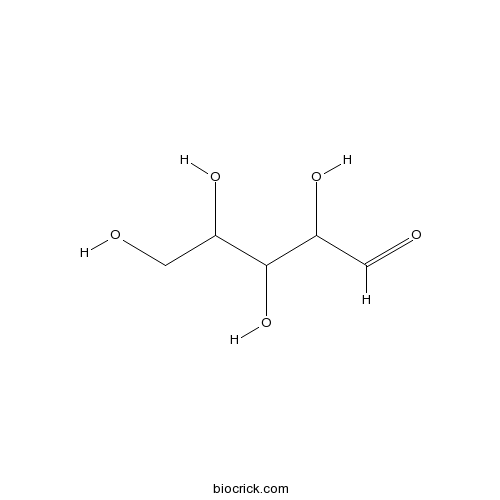DL-ArabinoseCAS# 147-81-9 |

- D-Arabinose
Catalog No.:BCN3791
CAS No.:10323-20-3
- D-(+)-Xylose
Catalog No.:BCN1010
CAS No.:58-86-6
- D-Ribose
Catalog No.:BCN9063
CAS No.:50-69-1
- L-xylose
Catalog No.:BCX0644
CAS No.:609-06-3
- D-Lyxose
Catalog No.:BCX0719
CAS No.:1114-34-7
Quality Control & MSDS
3D structure
Package In Stock
Number of papers citing our products

| Cas No. | 147-81-9 | SDF | Download SDF |
| PubChem ID | 854 | Appearance | Powder |
| Formula | C5H10O5 | M.Wt | 150.13 |
| Type of Compound | N/A | Storage | Desiccate at -20°C |
| Solubility | Soluble in Chloroform,Dichloromethane,Ethyl Acetate,DMSO,Acetone,etc. | ||
| Chemical Name | 2,3,4,5-tetrahydroxypentanal | ||
| SMILES | C(C(C(C(C=O)O)O)O)O | ||
| Standard InChIKey | PYMYPHUHKUWMLA-UHFFFAOYSA-N | ||
| Standard InChI | InChI=1S/C5H10O5/c6-1-3(8)5(10)4(9)2-7/h1,3-5,7-10H,2H2 | ||
| General tips | For obtaining a higher solubility , please warm the tube at 37 ℃ and shake it in the ultrasonic bath for a while.Stock solution can be stored below -20℃ for several months. We recommend that you prepare and use the solution on the same day. However, if the test schedule requires, the stock solutions can be prepared in advance, and the stock solution must be sealed and stored below -20℃. In general, the stock solution can be kept for several months. Before use, we recommend that you leave the vial at room temperature for at least an hour before opening it. |
||
| About Packaging | 1. The packaging of the product may be reversed during transportation, cause the high purity compounds to adhere to the neck or cap of the vial.Take the vail out of its packaging and shake gently until the compounds fall to the bottom of the vial. 2. For liquid products, please centrifuge at 500xg to gather the liquid to the bottom of the vial. 3. Try to avoid loss or contamination during the experiment. |
||
| Shipping Condition | Packaging according to customer requirements(5mg, 10mg, 20mg and more). Ship via FedEx, DHL, UPS, EMS or other couriers with RT, or blue ice upon request. | ||

DL-Arabinose Dilution Calculator

DL-Arabinose Molarity Calculator
| 1 mg | 5 mg | 10 mg | 20 mg | 25 mg | |
| 1 mM | 6.6609 mL | 33.3045 mL | 66.6089 mL | 133.2179 mL | 166.5223 mL |
| 5 mM | 1.3322 mL | 6.6609 mL | 13.3218 mL | 26.6436 mL | 33.3045 mL |
| 10 mM | 0.6661 mL | 3.3304 mL | 6.6609 mL | 13.3218 mL | 16.6522 mL |
| 50 mM | 0.1332 mL | 0.6661 mL | 1.3322 mL | 2.6644 mL | 3.3304 mL |
| 100 mM | 0.0666 mL | 0.333 mL | 0.6661 mL | 1.3322 mL | 1.6652 mL |
| * Note: If you are in the process of experiment, it's necessary to make the dilution ratios of the samples. The dilution data above is only for reference. Normally, it's can get a better solubility within lower of Concentrations. | |||||

Calcutta University

University of Minnesota

University of Maryland School of Medicine

University of Illinois at Chicago

The Ohio State University

University of Zurich

Harvard University

Colorado State University

Auburn University

Yale University

Worcester Polytechnic Institute

Washington State University

Stanford University

University of Leipzig

Universidade da Beira Interior

The Institute of Cancer Research

Heidelberg University

University of Amsterdam

University of Auckland

TsingHua University

The University of Michigan

Miami University

DRURY University

Jilin University

Fudan University

Wuhan University

Sun Yat-sen University

Universite de Paris

Deemed University

Auckland University

The University of Tokyo

Korea University
- Diphenhydramine hydrochloride
Catalog No.:BCC8947
CAS No.:147-24-0
- QL47
Catalog No.:BCC3920
CAS No.:1469988-75-7
- Atglistatin
Catalog No.:BCC5104
CAS No.:1469924-27-3
- Y-27632 dihydrochloride
Catalog No.:BCC1273
CAS No.:129830-38-2
- Y-27632
Catalog No.:BCC4301
CAS No.:146986-50-7
- Fmoc-Lys(Aloc)-OH
Catalog No.:BCC3515
CAS No.:146982-27-6
- Fmoc-Asp(OAll)-OH
Catalog No.:BCC3089
CAS No.:146982-24-3
- Codaphniphylline
Catalog No.:BCN1652
CAS No.:14694-15-6
- Ziprasidone
Catalog No.:BCC2071
CAS No.:146939-27-7
- K-Ras(G12C) inhibitor 12
Catalog No.:BCC5562
CAS No.:1469337-95-8
- K-Ras(G12C) inhibitor 9
Catalog No.:BCC6500
CAS No.:1469337-91-4
- 1,2-Diacetoxy-4,7,8-trihydroxy-3-(4-hydroxyphenyl)dibenzofuran
Catalog No.:BCN7691
CAS No.:146905-24-0
- Proline
Catalog No.:BCN1656
CAS No.:147-85-3
- Cytarabine
Catalog No.:BCC3759
CAS No.:147-94-4
- 3'-O-Demethylarctigenin
Catalog No.:BCN3544
CAS No.:147022-95-5
- Menthyl-5-(4-amino-2-oxo-2H-pyrimidin-1-yl)-[1,3]oxathiolane-2-carboxylic acid
Catalog No.:BCC9019
CAS No.:147027-10-9
- MK591
Catalog No.:BCC1766
CAS No.:147030-01-1
- Cyclo(Phe-Pro)
Catalog No.:BCN2416
CAS No.:14705-60-3
- Rocaglaol
Catalog No.:BCN1653
CAS No.:147059-46-9
- Trovafloxacin mesylate
Catalog No.:BCC3931
CAS No.:147059-75-4
- Alcaftadine
Catalog No.:BCC5260
CAS No.:147084-10-4
- 5,6-Dihydro-6-methyl-4H-thieno[2,3-b]thiopyran-4-one
Catalog No.:BCC8722
CAS No.:147086-79-1
- Rosuvastatin Calcium
Catalog No.:BCC3853
CAS No.:147098-20-2
- Maropitant
Catalog No.:BCC1728
CAS No.:147116-67-4
Herbaspirillum psychrotolerans sp. nov., a member of the family Oxalobacteraceae from a glacier forefield.[Pubmed:23456802]
Int J Syst Evol Microbiol. 2013 Sep;63(Pt 9):3197-203.
A novel psychrotolerant, Gram-negative, shiny white, curved-rod-shaped, facultatively anaerobic bacterium PB1(T) was isolated from a soil sample collected from a glacier forefield of the Larsemann Hills, East Antarctica. Isolate PB1(T) has catalase and low urease activity and hydrolyses gelatin and starch. Strain PB1(T) is able to grow between -5 degrees C and 30 degrees C with optimum growth at 14-20 degrees C. Glycerol, DL-Arabinose, d-xylose, d-galactose, d-fructose, d-lyxose, d-fucose and potassium gluconate are used as sole carbon sources. The major quinone is ubiquinone Q-8. The major fatty acids (>10%) for PB1(T) are C(16:0) (19.1%), C(16:1)omega7cis (44.6%) and C(18:1)omega7cis (16.2%). The major polyamines are putrescine [54.9 micromol (g dry weight)(-1)] and 2-hydroxy putrescine [18.5 micromol (g dry weight)(-1)]. DNA G+C content is 62.5 mol%. Strain PB1(T) is phylogenetically related to species of the genus Herbaspirillum, with highest 16S rRNA gene sequence similarities to Herbaspirillum canariense (97.3%), Herbaspirillum aurantiacum (97.2%), Herbaspirillum soli (97.2%) and Herbaspirillum frisingense (97.0%). The DNA-DNA relatedness values were below 30% between PB1(T) and the type strains of Herbaspirillum canariense, Herbaspirillum aurantiacum and Herbaspirillum soli. The different geographical origin of strain PB1(T) from its closest phylogenetic relatives resulted in different phenotypic and genotypic specifications, whereby strain PB(T) represents a novel species of the genus Herbaspirillum, for which the name Herbaspirillum psychrotolerans is proposed. The type strain is PB1(T) (DSM 26001(T) =LMG 27282(T)).


